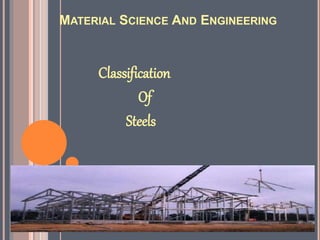
Classification of Steel
- 1. MATERIAL SCIENCE AND ENGINEERING Classification Of Steels
- 2. REFERENCES Materials Science and Engineering, V. Raghavan, Fifth Edition, Prentice Hall of India Pvt. Ltd., New Delhi, 2004. Materials Science and Engineering: An Introduction, William D. Callister John Wiley & Sons, 2010. ONLINE - Nptel
- 3. Ferrous Materials Ferrous Steels Cast iron Low Alloy High Alloy Tool steel Stainless steel
- 5. FERROUS MATERIAL - STEELS . –Low Carbon (<0.25 wt% C) –Medium Carbon (0.25 to 0.60 wt% C) –High Carbon (0.6 to 1.4 wt% C) • Steels - alloys of iron-carbon. - May contain other alloying elements. • Several grades are available • Low Alloy (<10 wt%) – Stainless Steel (>11 wt% Cr) - Tool Steel •High Alloy
- 6. EFFECT OF CARBON ON PROPERTIES OF STEELS
- 7. Low Carbon Steel - Also known as Mild Steel - Tensile strength of 555 N/mm - Hardness of 140 BHN - Bright fibrous structure - Tough , malleable , ductile and more elastic than wrought iron - Melting point 1410
- 8. Low Carbon Steel Plain carbon steels - very low content of alloying elements and small amounts of Mn. Most abundant grade of steel is low carbon steel – greatest quantity produced; least expensive. Not responsive to heat treatment; cold working needed to improve the strength. Good Weldability and machinability High Strength, Low Alloy (HSLA) steels - alloying elements (like Cu, V, Ni and Mo) up to 10 wt %; have higher strengths and may be heat treated.
- 9. LOW CARBON STEEL Compositions of some low carbon and low alloy steels
- 10. AISI - SAE CLASSIFICATION SYSTEM AISI XXXX American Iron and Steel Institute (AISI) classifies alloys by chemistry 4 digit number 1st number is the major alloying element 2nd number designates the subgroup alloying element OR the relative percent of primary alloying element. last two numbers approximate amount of carbon (expresses in 0.01%)
- 11. AISI - SAE CLASSIFICATION SYSTEM letter prefix to designate the process used to produce the steel E = electric furnace X = indicates permissible variations If a letter is inserted between the 2nd and 3rd number B = boron has been added L = lead has been added Letter suffix H = when hardenability is a major requirement Other designation organizations ASTM and MIL
- 14. MEDIUM CARBON STEEL Carbon content in the range of 0.3 – 0.6%. Can be heat treated - austenitizing, quenching and then tempering. Most often used in tempered condition – tempered martensite Medium carbon steels have low hardenability Addition of Cr, Ni, Mo improves the heat treating capacity Heat treated alloys are stronger but have lower ductility Typical applications – Railway wheels and tracks, gears, crankshafts.
- 15. MEDIUM CARBON STEEL - Bright fibrous structure when fractured - Tough and more elastic in comparison to wrought iron - Eaisly forged , welded , elongated due to ductility - Good malleability - Its tensile strength is better than cast iron and wrought iron - Compressive strength is better than wrought iron but lesser than cast iron
- 19. APPLICATIONS -
- 21. STRUCTURAL STEELS - Possess high strength and toughness - resistance to softening at elevated temperatures - resistance to corrosion - possess weldability , workability & high hardenability - principle alloying elements chromium , nickel , manganese
- 23. STAINLESS STEELS
- 26. EFFECTS OF ALLOYING ELEMENTS ON STEEL Manganese contributes to strength and hardness; dependent upon the carbon content. Increasing the manganese content decreases ductility and weldability. Manganese has a significant effect on the hardenability of steel. Phosphorus increases strength and hardness and decreases ductility and notch impact toughness of steel. The adverse effects on ductility and toughness are greater in quenched and tempered higher-carbon steels. Sulfur decreases ductility and notch impact toughness especially in the transverse direction. Weldability decreases with increasing sulfur content. Sulfur is found primarily in the form of sulfide inclusions. Silicon is one of the principal deoxidizers used in steelmaking. Silicon is less effective than manganese in increasing as-rolled strength and hardness. In low- carbon steels, silicon is generally detrimental to surface quality. Copper in significant amounts is detrimental to hot-working steels. Copper can be detrimental to surface quality. Copper is beneficial to atmospheric corrosion resistance when present in amounts exceeding 0.20%. Nickel is a ferrite strengthener. Nickel does not form carbides in steel. It remains in solution in ferrite, strengthening and toughening the ferrite phase. Nickel increases the hardenability and impact strength of steels. Molybdenum increases the hardenability of steel. It enhances the creep strength of low-alloy steels at elevated temperatures.